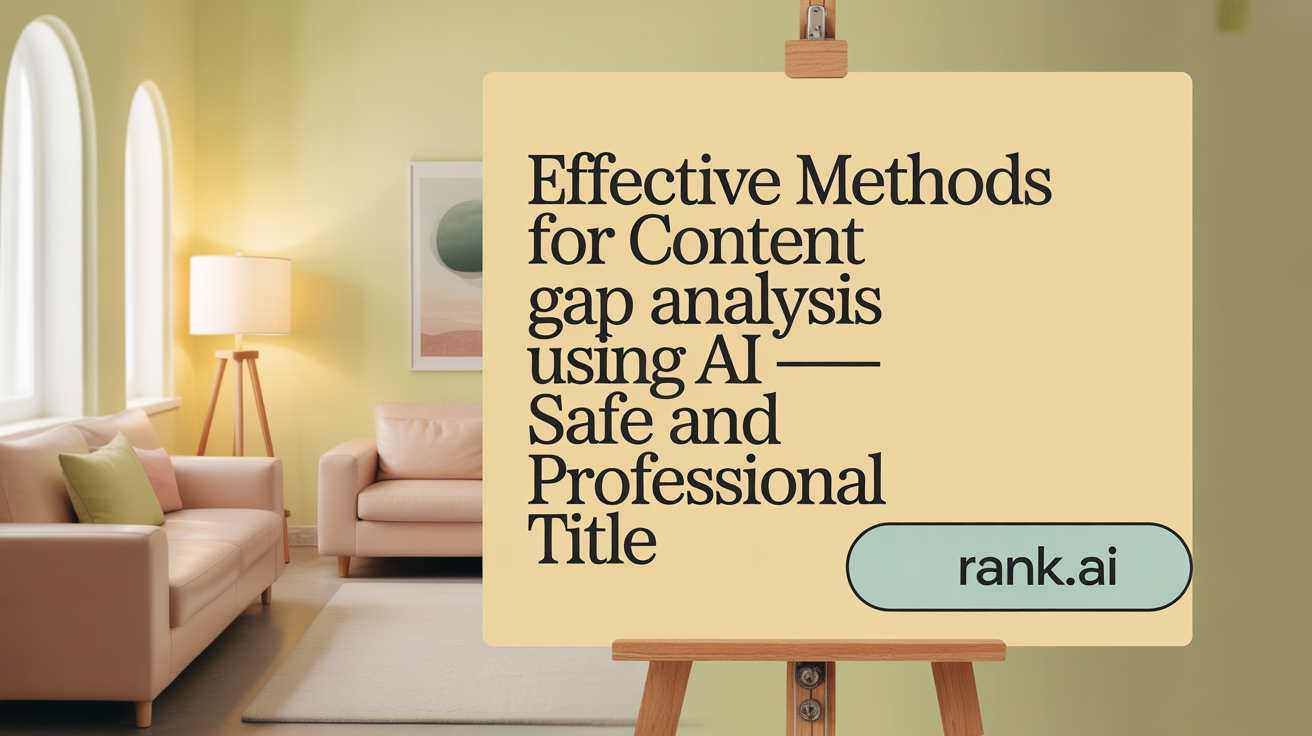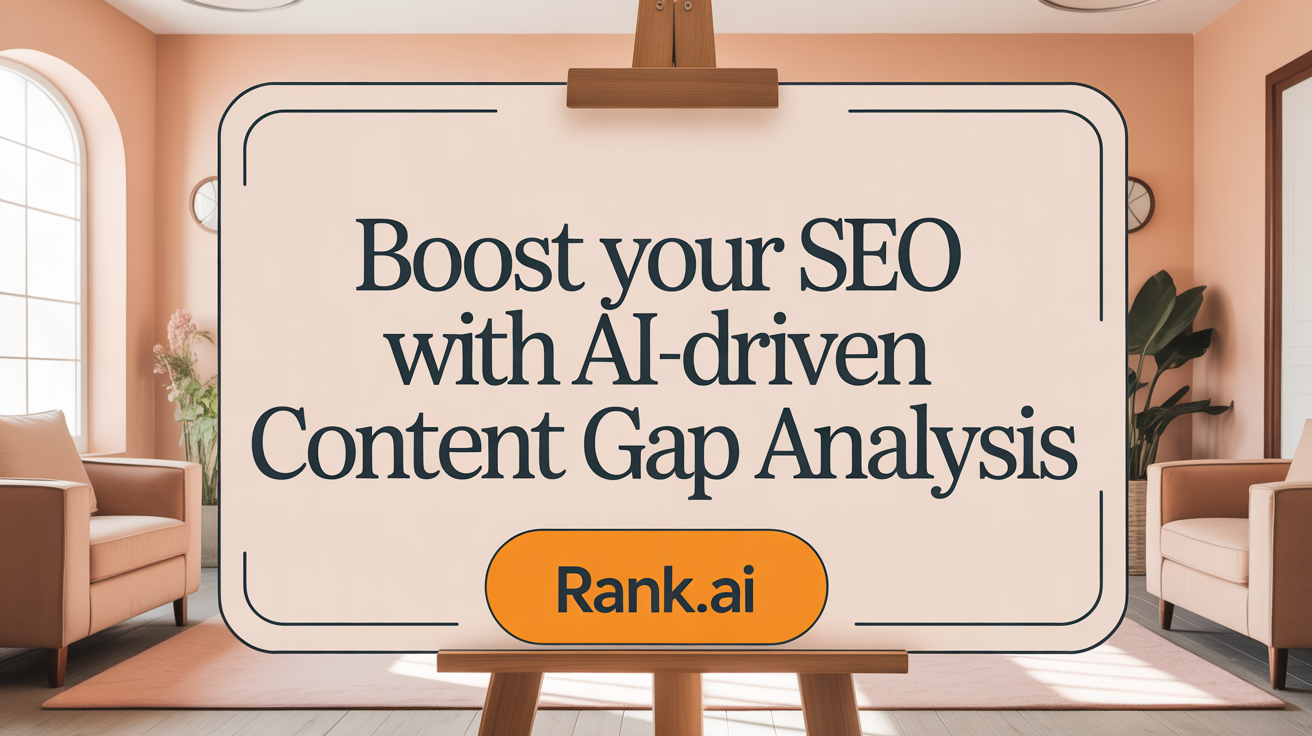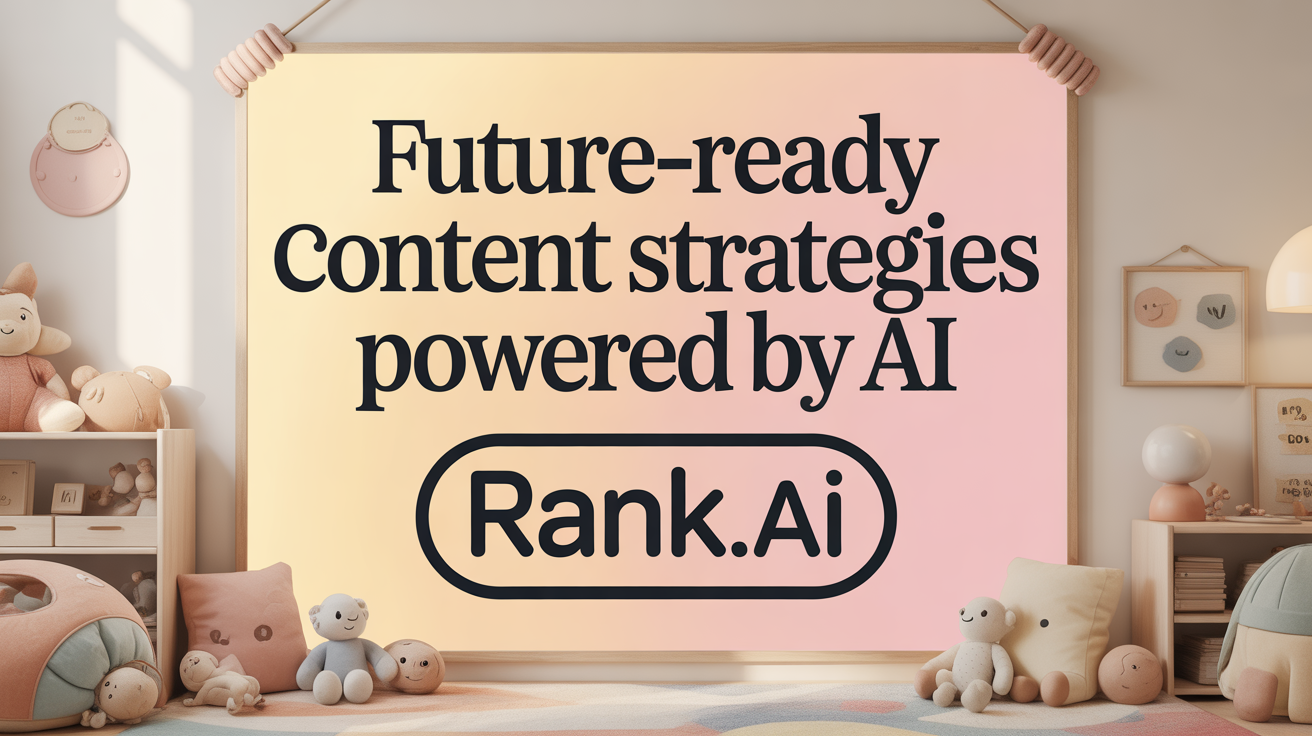Introduction to AI in Content Gap Analysis
In the rapidly evolving digital landscape, content strategies must continuously adapt to meet audience needs and stay ahead of competitors. Artificial intelligence (AI) is revolutionizing how marketers and content creators identify and address hidden content gaps. By leveraging advanced analytics, natural language processing, and machine learning, AI uncovers unmet customer needs, optimizes SEO efforts, and reveals new market opportunities. This article explores how AI transforms content gap identification and enables more effective, data-driven content strategies.
AI's Role, Methods, and Tools in Detecting Content Gaps
Artificial Intelligence (AI) plays an essential role in identifying content gaps that hinder website visibility and audience engagement. It does so by analyzing extensive data from social media, competitor websites, and user feedback to uncover topics, keywords, and media formats that are missing or underrepresented.
Key techniques such as Natural Language Processing (NLP), machine learning, and predictive analytics enable AI systems to process unstructured data quickly and accurately. NLP helps interpret open-ended survey responses, reviews, and social media comments to detect underlying customer needs and unspoken demands. Machine learning models can spot patterns and trends over time, enabling predictive insights about emerging topics or declining interest areas.
Popular AI tools for content gap analysis include SurferSEO, MarketMuse, and Frase.io. These platforms facilitate keyword opportunity discovery, competitor content benchmarking, and content optimization. AI-powered solutions, like ChatGPT, go further by assessing competitors' strategies, generating new content ideas, and even creating drafts tailored to audience interests.
Integrating AI into content planning involves mapping keywords, developing editorial calendars, and continuously monitoring content performance metrics such as organic traffic, bounce rates, and rankings. Real-time analytics allow marketers and content creators to adjust their strategies promptly, ensuring coverage of trending or underserved topics and maintaining a competitive edge.
By leveraging these AI methods and tools, organizations can develop more targeted content strategies, enhance user engagement, and improve overall search engine rankings. Continuous AI-driven monitoring ensures strategies evolve dynamically, aligning with changing audience preferences and search engine algorithms, ultimately leading to improved visibility and success in digital marketing.
Applying AI to Identify and Analyze Hidden Content Gaps
 AI plays a crucial role in uncovering content gaps that might be invisible through traditional analysis. By harnessing the power of natural language processing (NLP) and machine learning, organizations can sift through vast datasets to find missing or underrepresented topics.
AI plays a crucial role in uncovering content gaps that might be invisible through traditional analysis. By harnessing the power of natural language processing (NLP) and machine learning, organizations can sift through vast datasets to find missing or underrepresented topics.
One of the primary techniques involves semantic analysis, which helps AI understand the contextual meaning of content and identify areas that are undercovered. Pattern recognition algorithms analyze the relationships between words and concepts, revealing insights that aren't apparent from surface-level data.
AI also assesses content quality through metrics like perplexity and burstiness. Perplexity measures how well a language model predicts a given piece of text — high perplexity suggests more complex, diverse content, while low perplexity indicates repetitive or shallow coverage. Burstiness examines variations over time, helping identify trending or emerging topics that could be missing in existing content.
Combining these methods allows for a comprehensive approach. Semantic analysis and pattern recognition uncover the subtle gaps based on content relationships, while quality metrics guide the prioritization of topics to develop or improve.
Traditional content audits often focus on keyword rankings or traffic data, but AI broadens the scope by revealing hidden gaps that involve nuanced context and relevance. This helps content strategists craft more targeted, complete content plans.
In essence, AI-driven techniques facilitate a deep understanding of what is missing from current content landscapes, enabling more intelligent content creation that meets audience needs and improves search rankings.
Methods and Best Practices in AI-Driven Content Gap Analysis

What methods and best practices can be used for AI-driven content gap analysis?
AI-powered content gap analysis combines several effective strategies to help content creators discover what their audience searches for but cannot find. It begins with comprehensive content audits, where tools analyze your existing website content through metrics like keyword rankings, organic traffic, bounce rates, and backlinks. This process reveals underperforming content and uncovered opportunities.
Competitor research is equally crucial. Using AI tools such as Ahrefs, SEMrush, or MarketMuse, businesses can identify topics, keywords, and content formats that competitors target but are missing from their own content. These insights allow your team to fill those gaps and improve ranking prospects.
Social listening offers additional insights. Platforms like Hootsuite or Sprout Social scan social media, forums, and reviews to understand public sentiment and trending topics. Natural Language Processing (NLP) helps analyze open-ended feedback, uncovering unspoken needs and preferences.
Keyword research plays a vital role. AI tools can analyze search volume, user intent, and relevance to prioritize content ideas. For example, tools like AnswerThePublic or Moz Keyword Explorer help identify questions and queries your target audience is actively searching for.
Finally, ongoing monitoring and stakeholder engagement ensure that content strategies adapt to changing trends and audience demands. Continuous tracking of performance metrics and feedback, combined with AI automation, enables dynamic content planning. Crowdsourcing ideas and aligning content goals with business objectives are best practices to produce relevant, targeted content.
These methods, integrated with AI automation and data analytics, empower organizations to systematically identify and fill content gaps, ultimately boosting visibility and engagement.
Enhancing SEO Strategies by Identifying Content Gaps with AI

How can AI enhance SEO strategies by identifying content gaps?
AI plays a vital role in refining SEO efforts by providing detailed analysis of search engine data, keyword trends, and competitors' content. It efficiently scans vast datasets to discover topics your audience searches for but cannot find answers to on your site, identifying missing or underperforming content.
By evaluating your existing content, AI detects outdated, low-ranking, or shallow coverage, guiding you to update or expand these areas. It also uncovers new topics and questions emerging in your niche based on search intent, user queries, and trending keywords.
Competitor analysis is another area where AI shines. It examines top-ranking pages, highlighting themes, content formats, and engagement levels that your competitors utilize effectively. This data helps create targeted strategies to fill in gaps and outrank competitors.
AI-driven tools analyze large datasets from social media, reviews, forums, and market reports, providing insights into unmet customer needs. This predictive analysis allows your business to develop proactive content tailored to future search trends.
Incorporating AI into your SEO approach ensures more precise targeting, improved organic rankings, and higher user satisfaction by creating content that aligns closely with what your audience is seeking and what the market demands.
Uncovering Unmet Customer Needs and Market Opportunities via AI Content Analysis
AI significantly enhances businesses' ability to identify unmet customer needs and untapped market opportunities through comprehensive content analysis. By processing vast amounts of qualitative data—such as customer reviews, social media conversations, surveys, and feedback—AI tools employ advanced techniques like natural language processing (NLP) and sentiment analysis.
Sentiment analysis scans social media and review platforms to gauge public opinion, revealing both positive and negative responses toward products or services. This helps in identifying complaints or gaps indicating unmet demands.
Moreover, AI uncovers latent customer demands that may not be explicitly stated. By analyzing open-ended responses and unstructured feedback, AI detects underlying themes and unmet needs, providing strategic insights for innovation.
Benchmarking competitors is another vital aspect. AI compares market offerings, features, and customer sentiments across leading competitors to discover gaps or areas where competitors may be underperforming or missing targeted topics.
Utilizing predictive analytics, AI forecasts future trends and customer preferences. This proactive approach allows companies to tailor products and marketing strategies before demands fully manifest.
Natural language processing enables the rapid analysis of unstructured data, identifying recurring themes and uncovering hidden opportunities. Coupled with pattern recognition, AI reveals complex relationships and niches that may escape manual analysis.
Overall, AI empowers organizations with data-driven insights into customer needs and market gaps, accelerating innovation and strategic decision-making. By continuously monitoring trends and gathering intelligence from multiple sources, businesses can adapt swiftly and develop targeted solutions that meet emerging demands.
For further research, searching for "AI uncovering customer needs and market gaps" provides additional resources and case studies illustrating these capabilities.
Advantages of AI-Driven Market Analysis in Discovering Hidden Content Opportunities
 AI-driven market analysis offers numerous benefits when it comes to uncovering undiscovered content opportunities. One of its primary advantages is the ability to process information from diverse sources such as social media conversations, search engine data, customer reviews, and purchase histories. This comprehensive data gathering enables organizations to identify subtle consumer behaviors and emerging trends that traditional analysis might miss.
AI-driven market analysis offers numerous benefits when it comes to uncovering undiscovered content opportunities. One of its primary advantages is the ability to process information from diverse sources such as social media conversations, search engine data, customer reviews, and purchase histories. This comprehensive data gathering enables organizations to identify subtle consumer behaviors and emerging trends that traditional analysis might miss.
A notable strength of AI is its capacity for micro-segmentation — dividing audiences into highly specific groups based on nuanced preferences and behaviors. For example, AI can identify segments like ‘weekend splurgers’ or niche interest groups, allowing for highly targeted content strategies.
Predictive insights provided by AI help determine the best timing and context for releasing content. By analyzing patterns and trends, organizations can understand when and where their target audiences are most receptive, increasing engagement.
Furthermore, AI excels at analyzing unstructured data types such as images, videos, and textual comments using advanced techniques like natural language processing (NLP) and image recognition. This deep analysis uncovers community sentiments, desires, and unmet needs that are often hidden within large volumes of qualitative data.
AI also enhances the speed and accuracy of detecting anomalies or new market gaps, giving companies a competitive advantage. Quick identification of these opportunities allows for rapid content development and deployment, ensuring relevance and relevance.
In summary, AI-driven analysis empowers businesses with detailed insights, improves personalization, and optimizes resource allocation. By revealing hidden content opportunities, organizations can increase audience engagement, boost visibility, and foster growth in increasingly competitive markets.
Utilizing AI Techniques: Sentiment Analysis, Competitor Benchmarking, and NLP for Content Gap Identification
How are AI techniques like sentiment analysis, competitor benchmarking, and natural language processing used to identify content gaps?
AI techniques play a vital role in uncovering content gaps by analyzing various data sources and market signals. Sentiment analysis examines customer reviews, social media conversations, and public forums to understand how audiences feel about existing content and products. This helps identify unmet needs, emotional pain points, and topics that lack sufficient coverage.
Competitor benchmarking leverages AI-powered tools such as SEMrush, Ahrefs, and BuzzSumo to compare your content’s scope, quality, and reach against leading competitors. By analyzing keywords, backlinks, search rankings, and content formats, businesses can pinpoint areas where they are falling short or missing opportunities for growth.
Natural Language Processing (NLP) enables the analysis of large volumes of textual data, including customer feedback, survey responses, and open-ended reviews. It identifies recurring themes and unspoken demands that might not be immediately obvious through traditional analysis. This helps in uncovering latent needs and hidden content opportunities.
Advanced AI models, like GPT-4 and other Large Language Models (LLMs), enhance these efforts by understanding context, semantics, and nuances in language. They interpret customer sentiment, thematic relationships, and semantic variations, leading to more precise gap identification. These models also facilitate content ideation by generating suggestions based on identified needs.
Furthermore, AI-driven SEO and topical authority tools analyze trends, competitor content strategies, and search engine algorithms. Collectively, these techniques enable marketers and content creators to develop targeted, comprehensive content strategies that proactively address identified gaps, thereby boosting visibility, engagement, and market share.
Synergizing Concept Maps and AI for Knowledge and Content Gap Analysis
How do concept maps synergize with AI for knowledge and content gap analysis?
Concept maps are visual tools that display the relationships among ideas, topics, or concepts within a specific domain. They help organize knowledge in a structured manner, making it easier to see how different pieces of information connect.
When combined with AI, these maps become even more powerful. AI can analyze the structure of concept maps to pinpoint missing links or underdeveloped areas. For example, tools like InfraNodus examine keyword relationships and topical clusters to identify gaps where new content or knowledge should be developed.
AI enhances the process by generating specific content ideas aimed at filling these gaps. It can suggest new topics, improve semantic connections, and optimize the overall map for better coverage. Additionally, AI can compare search interest and content graph data, highlighting underserved areas or potential opportunities that competitors have not yet explored.
This partnership allows for more effective and dynamic gap analysis. It not only reveals what is missing but also guides strategic content creation to ensure comprehensive coverage. By leveraging AI’s pattern recognition and content generation, organizations can maintain a continuously evolving knowledge base that adapts to market changes and audience needs.
Overall, integrating concept maps with AI transforms static visualizations into active tools for identifying knowledge and content deficits, enabling smarter decision-making and richer content strategies.
Strategies and Future Trends in AI-Assisted Content Gap Identification and Bridging

What are the current strategies and future trends in AI-assisted content gap identification and bridging?
Presently, AI-based methods for detecting content gaps heavily rely on sophisticated natural language processing (NLP), machine learning algorithms, and big data analytics. These tools analyze enormous amounts of online data, including search queries, user behavior, and market discussions, to identify areas where content is lacking or underdeveloped.
Platforms like InfraNodus exemplify these strategies by visualizing relationships between keywords and topics. Such visualization helps organizations pinpoint underserved clusters of topics that their competitors may overlook. Using these insights, businesses can generate targeted ideas for creating content that fills identified gaps, often automating this process through AI-powered content ideation and optimization tools.
Looking ahead, the field is moving toward closer AI-human collaboration, where AI tools assist in real-time content adjustments based on emerging trends and audience feedback. Predictive models are also gaining prominence, allowing content strategies to anticipate future informational needs before gaps manifest visibly.
Emerging trends include more user-friendly AI integration platforms, such as no-code AI development tools that democratize access to advanced analytics. These platforms enable teams without deep technical expertise to implement AI-driven content strategies.
To stay competitive, organizations must address the widening AI skills gap by investing in staff training, forming strategic partnerships, and leveraging personalized learning platforms designed to build competencies in AI. By doing so, they can enhance their ability to utilize AI tools effectively, ensuring that content remains relevant and comprehensive.
Adapting to these future trends will be vital for content creators and marketers aiming to stay ahead of the evolving digital landscape, maintaining visibility and engagement in crowded marketplaces.
Conclusion: Embracing AI to Close Content Gaps and Seize Opportunities
Artificial intelligence is fundamentally reshaping how content creators and strategists discover and address hidden content gaps. By harnessing powerful AI techniques such as natural language processing, sentiment analysis, competitor benchmarking, and predictive analytics, businesses are empowered to uncover unmet customer needs, optimize SEO strategies, and identify untapped market opportunities. The synergy of AI with visualization tools like concept maps and ongoing advancements in AI-human collaboration herald a future where content strategies are more agile, precise, and personalized. Embracing these AI-driven methodologies and tools is essential for organizations aiming to maintain competitive advantage, improve audience engagement, and fuel sustained growth in an ever-changing digital ecosystem.
References
- How to Use AI Agents for Content Gap Analysis [+ Best Practices]
- Looking at Product Gaps with AI to Identify Demand - Pimberly
- Content Gap Analysis: Secret to Outrank Competitors-GetGenie
- How To Find Content Gaps: 2024 Guide On Where To Look
- Top AI Tools For Content Gap Analysis | ContentIn
- Content Gap Analysis: Full Guide & 5 Best Tools for 2025
- Using AI to Identify Gaps in the Market: Insights and Strategies for ...
- How to use AI tools to close knowledge gaps - Hubken Group
- AI-Powered Content Gap Analysis using ScrapeGraphAI and ... - N8N



